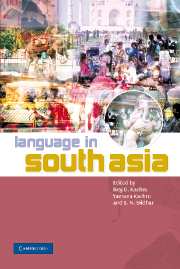Book contents
- Frontmatter
- Contents
- List of Figures
- List of Maps
- List of Tables
- Preface
- Acknowledgments
- List of Abbreviations
- Note on Transcription
- Introduction: languages, contexts, and constructs
- Part 1 Language history, families, and typology
- Part 2 Languages and their functions
- Part 3 Sanskrit and traditions of language study
- Part 4 Multilingualism, contact, and convergence
- Part 5 Orality, literacy, and writing systems
- Part 6 Language conflicts
- Part 7 Language and modernization
- Part 8 Language and discourse
- 17 Language in social and ethnic interaction
- 18 Language and the legal system
- 19 Language in the media and advertising
- 20 Language in cinema
- 21 Language of religion
- Part 9 Language and identity
- Part 10 Languages in diaspora
- References
- Subject Index
- Language Index
- Author Index
19 - Language in the media and advertising
Published online by Cambridge University Press: 04 May 2010
- Frontmatter
- Contents
- List of Figures
- List of Maps
- List of Tables
- Preface
- Acknowledgments
- List of Abbreviations
- Note on Transcription
- Introduction: languages, contexts, and constructs
- Part 1 Language history, families, and typology
- Part 2 Languages and their functions
- Part 3 Sanskrit and traditions of language study
- Part 4 Multilingualism, contact, and convergence
- Part 5 Orality, literacy, and writing systems
- Part 6 Language conflicts
- Part 7 Language and modernization
- Part 8 Language and discourse
- 17 Language in social and ethnic interaction
- 18 Language and the legal system
- 19 Language in the media and advertising
- 20 Language in cinema
- 21 Language of religion
- Part 9 Language and identity
- Part 10 Languages in diaspora
- References
- Subject Index
- Language Index
- Author Index
Summary
Introduction
The function of language in South Asian media is multifaceted, colorful, and distinct in a number of ways. These characteristics are the direct consequence of the complex linguistic, social, political, historical, and economic situation in the subcontinent. What might appear to be graffiti to an uninitiated Western eye may in fact turn out to be wall paintings whose evolution can be traced back to rock paintings of the sixth century bce. Wall painting in its present form makes an integral and distinct part of the South Asian media scene and symbolizes the economic and developmental vibrancy of the region. Other manifestations of this vibrancy are popular films by Bollywood (Bombay+Hollywood) cinema. Not only do they offer unique appeal in terms of cinematic techniques, dance, drama, and music, but they also offer a viable marketing alternative to Hollywood in the world of entertainment. Similarly, Hindi–Urdu music is notable for making inroads into the popular music of the youth of North America and other parts of the world. The reach of South Asian media indeed extends well beyond the one-third of the world's population that inhabits South Asia.
The scope of the topic at hand is quite vast in terms of its geographical and linguistic variants, media types, and their intrinsic manifestations. However, the focus of the chapter is to address the main issues that confront contemporary South Asian media.
- Type
- Chapter
- Information
- Language in South Asia , pp. 377 - 394Publisher: Cambridge University PressPrint publication year: 2008
- 3
- Cited by



